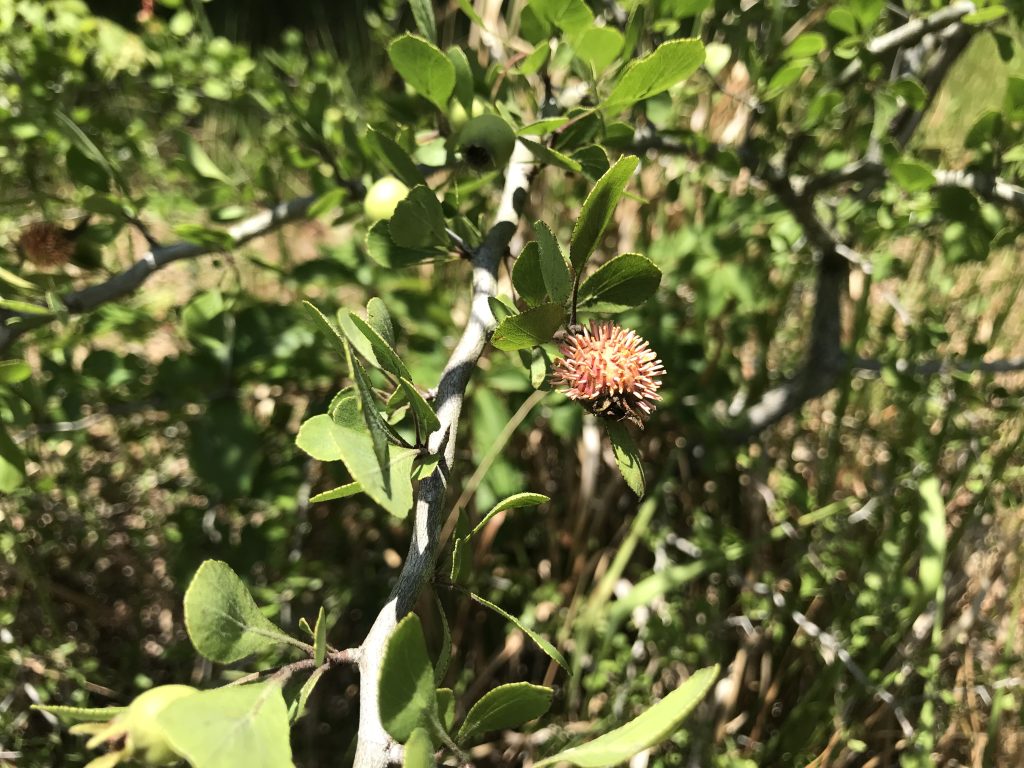
Gall on a Hawthorn. photo by Green Deane
Shall we get technical? Most foragers would look at this picture above and say that is a gall. beginners might think it’s a strange fruit . Plant galls are defined as abnormal plant growths caused by a gall-maker; the gall-maker being certain insects, mites, fungi, and bacteria. Locally Persea Borbornia usually has a lot galls — one of the identifying characteristics — and one particular scrub oak gets galls that look like cranberries.
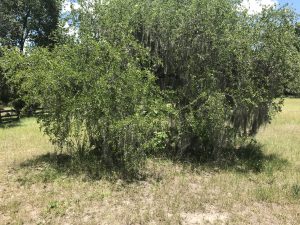
Hawthorn in Lithia Florida, usually not seen south of Ocala.
This is a gall on a Hawthorn fruit and is a fungus, Gymnosporangium clavipes, which is responsible for the disease known as Cedar-Quince Rust. The “cedar” in the relationship is actually the eastern red cedar, which is really a juniper, Juniperous virginana. This fungus must alternate between junipers and a member of the rose family, such as quince, hawthorn, crabapple, etc., to complete its life cycle. It spends a year on plant in the two groups then a year on the other plant.
Hawthorns are an unusual group of trees and can live to 400 yeras old. No one really knows how many species there are two hundred or 1,200. It is safe to say they vary a lot so identifying which one you have can be quite frustrating. The fruit is edible but not the seeds, and the fruit and leaves dried as a tea can be used for high blood pressure. Herbalists say two teaspoons of leaves or seedless berries (or both) made into a tea twice a day is an effective beta blocker and lowers blood pressure.
Ascross the dirt road I grew up on was a large hawthorn with two-inch thorns. Different species of birds would nest in the tree at the same time, because the thorns dissuaded egg and chick predator. Unncessary tarring and widening of the road eliminated the tree.

Range of the one-seeded Hawthorn
Historically hawthorns have been used to make hedgerows and “haw” means hedge. The fruit is a source of pectin. In fact one, Crataegus monogyna, the one-seed Hawthorn can be made into a no-cook jelly. Put the berries in a bowl and quickly crush them thoroughly with your hands. The resulting liquid should be about the consistency of pudding just before it sets. It should be that consistency naturally. If you’ve had a dry year add some water to get to that consistency. Work quickly. Squeeze the seeds out of the berries then quickly filter the thick slurry into a bowl. In about five minutes the liquid will jell. Flip it over onto a plate. It can be eaten as is or sliced or sun dried. It will be sweet and will last for many years. Remember just ripe berries have more pectin that over-ripe berries. To see a video on this go here.
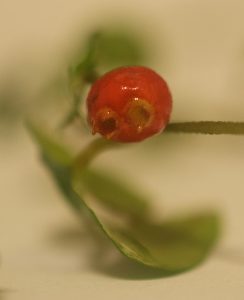
Partridgeberry has two dimples where twin blossoms were. Photo by Green Deane
It is the season time for partridgeberries. While they can be found locally they are more a cooler climate species. I used to find them occasionally in Gainesville Fl but saw them often in western North Carolina. Botanically Michlla repens, the species has been used for food and as a diureticc and for the pain associalted wiht menstrual cramps and child birth. M. repens is a vine that does not climb. It does make an excellent ground cover. The berry is favored by the ruffed grouse hence the name Partridgeberry.
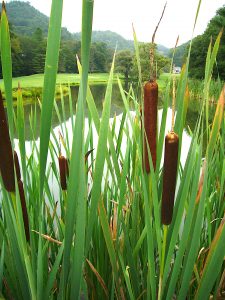
Cattails tops in North Carolina. Photo by Green Deane
If you were starving and came upon a patch of cattails (blossoming now) you would have great cause for celebration. You have found food and water. You will survive. But if you are not starving and do not have all the time in the inter-connected world you just might find cattails highly overrated. It is true that no plant can produce more starch per acre than cattails, about 3.5 tons under cultivation. And it can produce a lot of starch economically if you can mechanize the extraction. But hand extraction is time- consuming and labor intensive. It is also wet, smelly work all of which can be worsened significantly by harvesting in cold weather. So yes, cattails are food but the time demand is such that harvesting food has to be your prime occupation. A similar argument can be made for kudzu. The roots do have edible starch but it takes a gargantuan amount of work to get the starch out, literally hours of steady pounding. It is not a calorie positive activity. It moves you closer to starvation. But, mechanize the process with some hammers run by falling water — or pounding hammers run by a horse fed on an endless supply of grass — and kudzu becomes a reliable calorie-positive food. You can see my video on cattails here. I also have an article on Finding Caloric Staples with links to relevant videos.
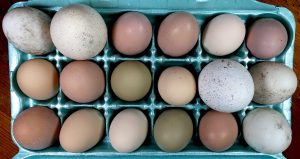
Turkey, duck and several different chicken eggs, Photo by Green Deane
Though demonized, forgiven, and demonized again eggs have always been a large part of the human diet. A local farm store has sales that sometimes includes duck eggs which I grew up eating. We also had chickens (and pet squirrels, rabbits, dogs, cats and horses… my mother collected horses and I had to take care of them so much that in 1969 I volunteered for the Army and Vietnam to get away from horses and haying.) I was given three dozen duck eggs from my cousin while teaching in South Carolina a couple of weeks ago, Many Thanks. A few years ago I noticed that most “survivalist” and or “prepper” sites and articles oddly did not mention eggs which were a prime seasonal food of our ancestors.. That prompted me to write a large article on eggs, birds to fish. You can read it here.
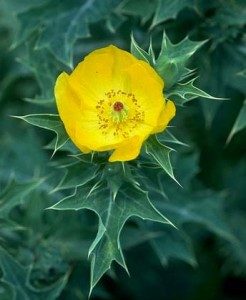
Mexican Poppy, can also have a while blossom. Photo by Green Deane
No, it’s not edible. Depending on the weather I receive numerous emails wanting me to identify a yellow- or white-blossomedextremely prickly plant (left). It’s almost always Argemone mexicana, the Mexican Poppy. Some years they bloom as early as Christmas or can still be blossoming in May. The species is found in dry areas in much of eastern North America avoiding some north mid-west states and northern New England. Highly toxic, the Mexican Poppy tastes bad and is so well-armed that accidental poisonings amongst man or beast are few. It is a plant that does not want to be eaten. However people have tried to use its seeds for cooking oil resulting in severe edema (water retention.) Herbalists, however, use the plant extensively (which brings up the importance of knowing what you’re doing.) Toxicity reportedly occurs only when large quantities are ingested and the plant might have primitive uses in treating malaria. In one study it helped three quarters of the patients but did not completely get rid of the parasitic load. The most common places to see the very prickly plant is beside roads and railroad tracks.
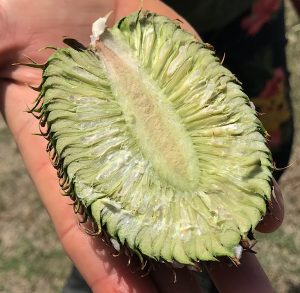
Undeveloped seeds in the Norfolk Pine cone. Photo by Green Deane
The Bunya Bunya and Norfolk Pine are closely related. Neither look good in landscaping though the Norfolk Pine is far more common than the Bunya Buyna locally. They both awkwardly stand out. Unlike cones of the Bunya Bunya, which one finds regularly, Norfolk pine cones are more rare. And like their relative they, too, have edible seeds. During a class in Port Charlotte we saw an immature Norfolk Pine cone. The undeveloped seeds were intensely pine flavored. The Bunya Bunya fruits about every three years. One sees Norfolk Pines regularly but not their cones. Hopefully this tree will drop some mature cones in August which is also about when the champagne mangos in the area ripen (and rot on the ground.)
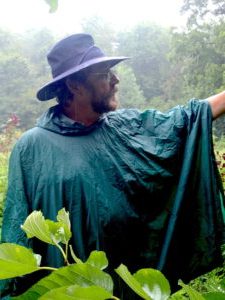
Classes are held rain or shine (but not during hurricanes.)
We might have to dodge rain during foraging classes this weekend but that means less heat, always good.
Saturday May 21st Eagle Park Lake, 1800 Keene Road, Largo, FL 33771. 9 a.m. to noon Meet at the pavilion near the dog park.
Sunday May 22nd, Colby-Alderman Park: 1099 Massachusetts Street, Cassadaga Fla. 32706, 9 a.m. to noon. Meet at the bathrooms
Saturday May 28th Bayshore Live Oak Park, Bayshore Drive. Port Charlotte. 9 a.m. to0 noon. Meet at the parking lot at Bayshore and Ganyard.
Sunday May 29th Mead Gardens, 1500 S. Denning Dr., Winter Park, FL 32789. 9 a.m. to noon Meet at the bathrooms.
For more information, to pre-pay or sign up go here

You get the USB, not the key.
My nine-DVD set of 135 videos has been phased out and replaced by 171-videos on a 128-GB USB, see left. The USB videos are the same videos I have on You Tube. Some people like to have their own copy especially if social order falters. The USB videos have to be copied to your computer to play. If you want to order the USB go to the DVD/USB order button on the top right of this page or click here. That will take you to an order form. Or you can make a $99 donation, which tells me it is for the USB (include a snail-mail address.) I’d like to thank all of you who ordered the DVD set over the years which required me to burn over 5,000 DVDs individually. I had to stop making them as few programs now will read the ISO files to copy them. Burning a set also took about three hours.

Green Deane Forum
Want to identify a plant? Perhaps you’re looking for a foraging reference? You might have a UFO, an Unidentified Flowering Object, you want identified. On the Green Deane Forum we — including Green Deane and others from around the world — chat about foraging all year. And it’s not just about warm-weather plants or just North American flora. Many nations share common weeds so there’s a lot to talk about. There’s also more than weeds. The reference section has information for foraging around the world. There are also articles on food preservation, and forgotten skills from making bows to fermenting food. Recent topics include: Fermenting potatoeswith yogurt, make a water filter, nixtamalization at home, Stale Bread and Cod Liver Oil, Life’s a Grind, Killing Bugs with Tobacco Plugs, Eating weeds: Is it safe? Have they mutated? Not the Eastern Red Bug but the Pink Tabebuia, African Tulip Tree, Asparagus densiflorus, Green Deane’s Book… You can join the forum by clicking on the button on the upper right hand side of this page.
Is commercial food catchng up with us? Here you see purslane being sold in a farm store near Olando.
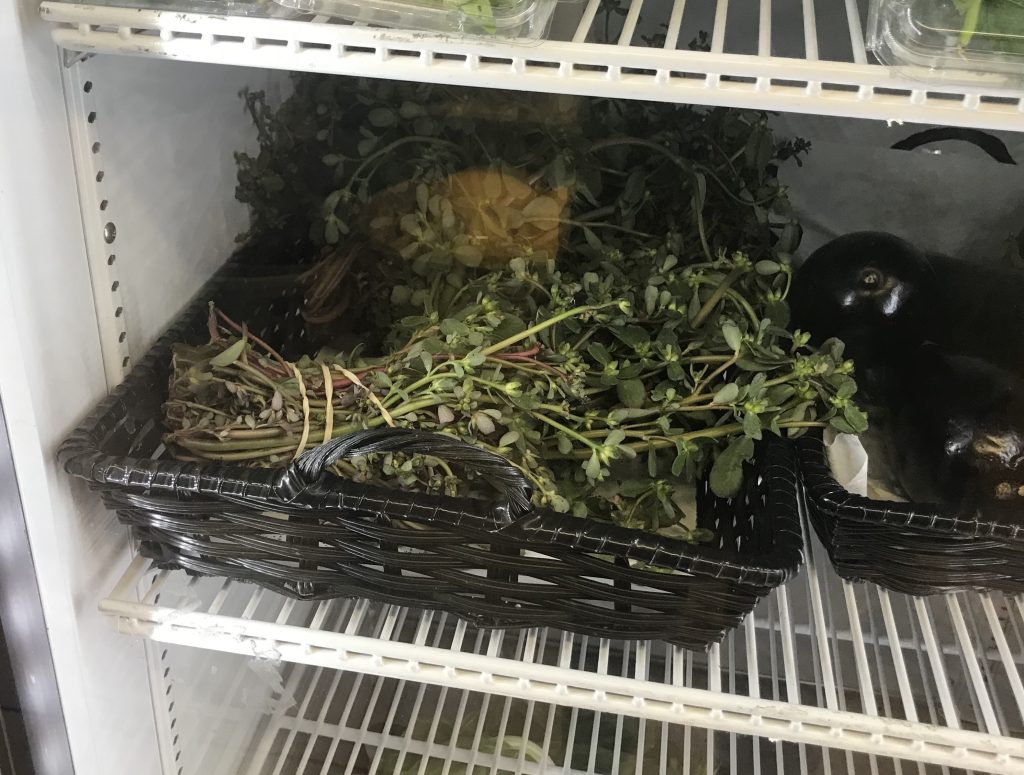
Yellow -blossomed Purslane, raised on the farm.
This is my weekly newsletter #508. If you want to subscribe to this free newsletter you can find the sign-up form in the menu at the top of the page. My website, EatTheWeeds.com, which is data secure, has over 1500 plants on it in some 428 articles. I wrote every one myself, no cut and paste.
To donate to the Green Deane Newsletter click here.


We have partridge berry growing all under the oaks in our front yard here in Bronson near the powerlines and Station Pond. Feel free to gather some any time you’re by this way although it’s rare to see the berries since we also have squirrels, field mice, possums and raccoons. Oh, and visiting deer. 🙂